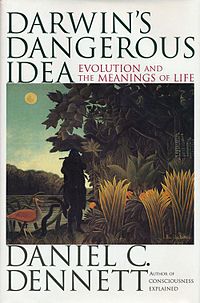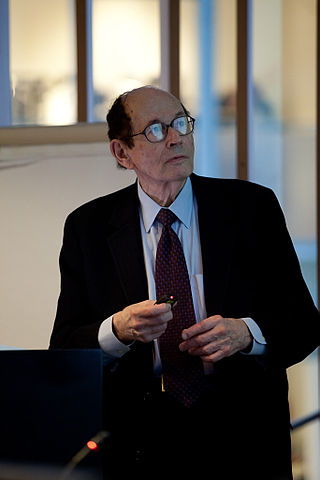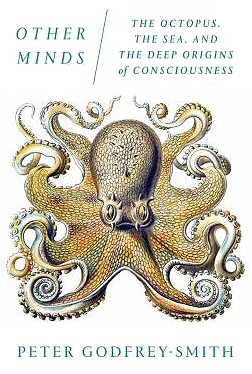
Daniel Clement Dennett III is an American philosopher, writer, and cognitive scientist whose research centers on the philosophy of mind, philosophy of science, and philosophy of biology, particularly as those fields relate to evolutionary biology and cognitive science.

Darwin's Dangerous Idea: Evolution and the Meanings of Life is a 1995 book by the philosopher Daniel Dennett, in which the author looks at some of the repercussions of Darwinian theory. The crux of the argument is that, whether or not Darwin's theories are overturned, there is no going back from the dangerous idea that design might not need a designer. Dennett makes this case on the basis that natural selection is a blind process, which is nevertheless sufficiently powerful to explain the evolution of life. Darwin's discovery was that the generation of life worked algorithmically, that processes behind it work in such a way that given these processes the results that they tend toward must be so.
Memetics is a study of information and culture based on an analogy with Darwinian evolution. Proponents of memetics, as evolutionary culture, describe it as an approach of cultural information transfer. Those arguing for the Darwinian theoretical account tend to begin with theoretical analogies from existing biological evolutionary models. Memetics describes how ideas or cultural information can propagate, but doesn't necessarily imply a meme's concept is factual.

Neural Darwinism is a biological, and more specifically Darwinian and selectionist, approach to understanding global brain function, originally proposed by American biologist, researcher and Nobel-Prize recipient Gerald Maurice Edelman. Edelman's 1987 book Neural Darwinism introduced the public to the theory of neuronal group selection (TNGS) – which is the core theory underlying Edelman's explanation of global brain function.

Mind uploading is a speculative process of whole brain emulation in which a brain scan is used to completely emulate the mental state of the individual in a digital computer. The computer would then run a simulation of the brain's information processing, such that it would respond in essentially the same way as the original brain and experience having a sentient conscious mind.

Gerald Maurice Edelman was an American biologist who shared the 1972 Nobel Prize in Physiology or Medicine for work with Rodney Robert Porter on the immune system. Edelman's Nobel Prize-winning research concerned discovery of the structure of antibody molecules. In interviews, he has said that the way the components of the immune system evolve over the life of the individual is analogous to the way the components of the brain evolve in a lifetime. There is a continuity in this way between his work on the immune system, for which he won the Nobel Prize, and his later work in neuroscience and in philosophy of mind.

Daniel Goleman is an American psychologist, author, and science journalist. For twelve years, he wrote for The New York Times, reporting on the brain and behavioral sciences. His 1995 book Emotional Intelligence was on The New York Times Best Seller list for a year and a half, a bestseller in many countries, and is in print worldwide in 40 languages. Apart from his books on emotional intelligence, Goleman has written books on topics including self-deception, creativity, transparency, meditation, social and emotional learning, ecoliteracy and the ecological crisis, and the Dalai Lama's vision for the future.
Robert Evan Ornstein was an American psychologist, researcher and author.

A cortical column is a group of neurons forming a cylindrical structure through the cerebral cortex of the brain perpendicular to the cortical surface. The structure was first identified by Mountcastle in 1957. He later identified minicolumns as the basic units of the neocortex which were arranged into columns. Each contains the same types of neurons, connectivity, and firing properties. Columns are also called hypercolumn, macrocolumn, functional column or sometimes cortical module. Neurons within a minicolumn (microcolumn) encode similar features, whereas a hypercolumn "denotes a unit containing a full set of values for any given set of receptive field parameters". A cortical module is defined as either synonymous with a hypercolumn (Mountcastle) or as a tissue block of multiple overlapping hypercolumns.
A Darwin machine is a machine that, like a Turing machine, involves an iteration process that yields a high-quality result, but, whereas a Turing machine uses logic, the Darwin machine uses rounds of variation, selection, and inheritance.
Evolutionary neuroscience is the scientific study of the evolution of nervous systems. Evolutionary neuroscientists investigate the evolution and natural history of nervous system structure, functions and emergent properties. The field draws on concepts and findings from both neuroscience and evolutionary biology. Historically, most empirical work has been in the area of comparative neuroanatomy, and modern studies often make use of phylogenetic comparative methods. Selective breeding and experimental evolution approaches are also being used more frequently.
An artificial brain is software and hardware with cognitive abilities similar to those of the animal or human brain.
The evolution of human intelligence is closely tied to the evolution of the human brain and to the origin of language. The timeline of human evolution spans approximately seven million years, from the separation of the genus Pan until the emergence of behavioral modernity by 50,000 years ago. The first three million years of this timeline concern Sahelanthropus, the following two million concern Australopithecus and the final two million span the history of the genus Homo in the Paleolithic era.

Geoffrey Franklin Miller is an American evolutionary psychologist, author, and associate professor of psychology at the University of New Mexico. He is known for his research on sexual selection in human evolution.
Neuroanthropology is the study of the relationship between culture and the brain. This field of study emerged from a 2008 conference of the American Anthropological Association. It is based on the premise that lived experience leaves identifiable patterns in brain structure, which then feed back into cultural expression.The exact mechanisms are so far ill defined and remain speculative.

Animal consciousness, or animal awareness, is the quality or state of self-awareness within an animal, or of being aware of an external object or something within itself. In humans, consciousness has been defined as: sentience, awareness, subjectivity, qualia, the ability to experience or to feel, wakefulness, having a sense of selfhood, and the executive control system of the mind. Despite the difficulty in definition, many philosophers believe there is a broadly shared underlying intuition about what consciousness is.

The evolutionary origin of religion and religious behavior is a field of study related to evolutionary psychology, the origin of language and mythology, and cross-cultural comparison of the anthropology of religion. Some subjects of interest include Neolithic religion, evidence for spirituality or cultic behavior in the Upper Paleolithic, and similarities in great ape behavior.
The concept of conscious evolution refers to the theoretical ability of human beings to become conscious participants in the evolution of their cultures, or even of the entirety of human society, based on a relatively recent combination of factors, including increasing awareness of cultural and social patterns, reaction against perceived problems with existing patterns, injustices, inequities, and other factors. The realization that cultural and social evolution can be guided through conscious decisions has been in increasing evidence since approximately the mid-19th century, when the rate of cultural change globally began to increase dramatically. The Industrial Revolution, reactions against the effects of the Industrial Revolution, the emergence of new sciences such as psychology, anthropology, and sociology, the revolution in global communication, the interaction of diverse cultures through transportation and colonization, anti-slavery and suffrage movements, and increasing human lifespan all would contribute to the growing awareness of social and cultural patterns as being potentially subject to conscious evolution.

How to Create a Mind: The Secret of Human Thought Revealed is a non-fiction book about brains, both human and artificial, by the inventor and futurist Ray Kurzweil. First published in hardcover on November 13, 2012 by Viking Press it became a New York Times Best Seller. It has received attention from The Washington Post, The New York Times and The New Yorker.

Other Minds is a 2016 bestseller by Peter Godfrey-Smith on the evolution and nature of consciousness. It compares the situation in cephalopods, especially octopuses and cuttlefish, with that in mammals and birds. Complex active bodies that enable and perhaps require a measure of intelligence have evolved three times, in arthropods, cephalopods, and vertebrates. The book reflects on the nature of cephalopod intelligence in particular, constrained by their short lifespan, and embodied in large part in their partly autonomous arms which contain more nerve cells than their brains.












